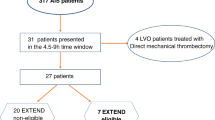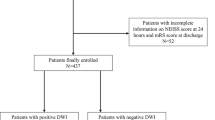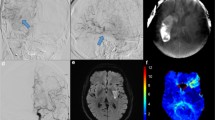Abstract
Introduction
Intravenous thrombolysis (IVT) is a standard treatment for both anterior circulation ischaemic stroke (ACIS) and posterior circulation ischaemic stroke (PCIS). Our aim was to evaluate the predictors for a good clinical outcome and intracerebral haemorrhage (ICH) in patients undergoing posterior circulation IVT based on the initially performed CT or MR imaging.
Methods
The study cohort consisted of 1643 consecutive patients with acute ischaemic stroke (1440 ACIS, 203 PCIS cases) who underwent IVT. ICH was classified according to the European Cooperative Acute Stroke Study (ECASS) I protocol. Clinical outcome was assessed using the modified Rankin scale (mRS). Early ischaemic signs and pre-existing structural signs were assessed.
Results
Good clinical outcomes (mRS 0–1) were noted in 45.3% of patients with PCIS, with a mortality rate of 14.8%. ICH was noted in 8.3%, and a large haemorrhage was found in 2.4% of patients. Some early ischaemic signs and pre-existing structural signs on initial CT/MR imaging correlated significantly with the 90-day clinical outcome.
Conclusions
Early ischaemic signs and pre-existing structural signs should be considered during the assessment of patients with PCIS eligible for IVT. Tissue hypoattenuation on initial CT scans correlates with an increased risk of death. Similarly to anterior circulation, atrophy on initial MRI may negatively predict good clinical outcome in posterior circulation.





Similar content being viewed by others
References
Wardlaw JM, Murray V, Berge E, del Zoppo GJ. Thrombolysis for acute ischemic stroke. Cochrane Database Syst Rev. 2014;29(7):CD000213.
Emberson J, Lees KR, Lyden P, et al. Effect of treatment delay, age, and stroke severity on the effects of intravenous thrombolysis with alteplase for acute ischemic stroke: a meta-analysis of individual patient data from randomised trials. Lancet. 2014;384(9958):1929–35.
Wardlaw JM, Sandercock P, Cohen G, et al. Association between brain imaging signs, early and late outcomes, and response to intravenous alteplase after acute ischemic stroke in the third International Stroke Trial (IST-3): secondary analysis of a randomised controlled trial. Lancet Neurol. 2015;14(5):485–96.
von Kummer R, Bourquain H, Bastianello S, et al. Early prediction of irreversible brain damage after ischemic stroke at CT. Radiology. 2001;219(1):95–100.
Hacke W, Kaste M, Fieschi C, et al. Intravenous thrombolysis with recombinant tissue plasminogen activator for acute hemispheric stroke. The European Cooperative Acute Stroke Study (ECASS). JAMA. 1995;274(13):1017–25.
Appleton JP, Woodhouse LJ, Adami A, et al. Imaging markers of small vessel disease and brain frailty, and outcomes in acute stroke. Neurology. 2020;94(5):e439–52.
Whiteley WN, Emberson J, Lees KR, et al. Risk of intracerebral haemorrhage with alteplase after acute ischemic stroke: a secondary analysis of an individual patient data meta-analysis. Lancet Neurol. 2016;15(9):925–33.
Dorňák T, Král M, Šaňák D, Kaňovský P. Intravenous thrombolysis in posterior circulation stroke. Front Neurol. 2019;10:417.
Dorňák T, Král M, Sedláčková Z, et al. Predictors for intracranial hemorrhage following intravenous thrombolysis in posterior circulation stroke. Transl Stroke Res. 2018;9(6):582–8.
Dornak T, Herzig R, Sanak D, Skoloudik D. Management of acute basilar artery occlusion: should any treatment strategy prevail? Biomed Pap Med Fac Univ Palacky Olomouc Czech Repub. 2014;158(4):528–34.
Olsen TS, Langhorne P, Diener HC, et al. European Stroke Initiative recommendations for stroke management-update 2003. Cerebrovasc Dis. 2003;16(4):311–37.
European Stroke Organisation (ESO) Executive Committee ESO; Writing Committee. Guidelines for management of ischemic stroke and transient ischemic attack. Cerebrovasc Dis 2008; 25(5):457–507.
European Stroke Organisation (ESO) Executive Committee; ESO Writing Committee. Should the time window for intravenous thrombolysis be extended? https://www.congrex-switzerland.com/fileadmin/files/2013/eso-stroke/pdf/ESO_Guideline_Update_Jan_2009.pdf. Accessed 4 Nov 2020.
Dorňák T, Král M, Hazlinger M, et al. Posterior vs. anterior circulation infarction: demography, outcomes, and frequency of hemorrhage after thrombolysis. Int J Stroke. 2015;10(8):1224–8.
Tei H, Uchiyama S, Usui T, Ohara K. Posterior circulation ASPECTS on diffusion-weighted MRI can be a powerful marker for predicting functional outcome. J Neurol. 2010;257(5):767–73.
Barber PA, Demchuk AM, Zhang J, Buchan AM. Validity and reliability of a quantitative computed tomography score in predicting outcome of hyperacute stroke before thrombolytic therapy. ASPECTS Study Group. Alberta Stroke Programme Early CT Score. Lancet. 2000;355(9216):1670–4.
Savoiardo M, Grisoli M. Computed tomography scanning. In: Barnett HJM, Mohr JP, Stein BM, Yatsu FM, editors. Stroke: pathophysiology, diagnosis and management. 4th ed. Philadelphia: Churchill Livingstone; 2004; p. 196–200.
Prakkamakul S, Yoo AJ. ASPECTS CT in acute ischemia: review of current data. Top Magn Reson Imaging. 2017;26(3):103–12.
van Swieten JC, Kappelle LJ, Algra A, van Latum JC, Koudstaal PJ, van Gijn J. Hypodensity of the cerebral white matter in patients with transient ischemic attack or minor stroke: influence on the rate of subsequent stroke. Dutch TIA Trial Study Group. Ann Neurol. 1992;32(2):177–83.
Fazekas F, Chawluk JB, Alavi A, Hurtig HI, Zimmerman RA. MR signal abnormalities at 1.5 T in Alzheimer’s dementia and normal aging. AJR Am J Roentgenol. 1987;149(2):351–6.
Kim KW, MacFall JR, Payne ME. Classification of white matter lesions on magnetic resonance imaging in elderly persons. Biol Psychiatr. 2008;64(4):273–80.
Renou P, Sibon I, Tourdias T, et al. Reliability of the ECASS radiological classification of postthrombolysis brain haemorrhage: a comparison of CT and three MRI sequences. Cerebrovasc Dis. 2010;29(6):597–604.
Sandercock P, Wardlaw JM, Lindley RI, et al. The benefits and harms of intravenous thrombolysis with recombinant tissue plasminogen activator within 6 h of acute ischemic stroke (the third International Stroke Trial [IST-3]): a randomised controlled trial. Lancet. 2012;379(9834):2352–63.
Shamy MC, Jaigobin CS. The complexities of acute stroke decision-making: a survey of neurologists. Neurology. 2013;81(13):1130–3.
Searls DE, Pazdera L, Korbel E, Vysata O, Caplan LR. Symptoms and signs of posterior circulation ischemia in the New England Medical Center posterior circulation registry. Arch Neurol. 2012;69(3):346–51.
Liberman AL, Prabhakaran S. Stroke chameleons and stroke mimics in the emergency department. Curr Neurol Neurosci Rep. 2017;17(2):15.
Rudkin S, Cerejo R, Tayal A, Goldberg MF. Imaging of acute ischemic stroke. Emerg Radiol. 2018;25(6):659–72.
Sato S, Toyoda K, Uehara T, et al. Baseline NIH Stroke Scale Score predicting outcome in anterior and posterior circulation strokes. Neurology. 2008;70(24 Pt2):2371–7.
Burns JD, Rindler RS, Carr C, et al. Delay in diagnosis of basilar artery stroke. Neurocrit Care. 2016;24(2):172–9.
Cumming TB, Marshall RS, Lazar RM. Stroke, cognitive deficits, and rehabilitation: still an incomplete picture. Int J Stroke. 2013;8(1):38–45.
Werner MF, López-Rueda A, Zarco FX, et al. Value of posterior circulation ASPECTS and Pons-Midbrain Index on non-contrast CT and CT angiography source images in patients with basilar artery occlusion recanalized after mechanical thrombectomy. Radiologia. 2019;61(2):143–52.
Marinković SV, Gibo H. The surgical anatomy of the perforating branches of the basilar artery. Neurosurgery. 1993;33(1):80–7.
Puetz V, Sylaja PN, Coutts SB, et al. Extent of hypoattenuation on CT angiography source images predicts functional outcome in patients with basilar artery occlusion. Stroke. 2008;39(9):2485–90.
Powers WJ, Rabinstein AA, Ackerson T, et al. 2018 Guidelines for the early management of patients with acute ischemic stroke: a guideline for healthcare professionals from the American Heart Association/American Stroke Association. Stroke. 2018;49(3):e46–110.
Acknowledgements
Funding
This study was conducted on an academic basis and was supported by AZV CR – Health Research Council of the Czech Republic no. 17-29452A, 17-30101A and NV19-06-00216; by grant project LO1304 from the Ministry of Education of the Czech Republic; by the institutional support of the Ministry of Health of the Czech Republic MH CZ – DRO (FNOL, 00098892) –2018,2019,2020. The journal’s rapid service fee was also funded by the above mentioned grants.
Authorship
All named authors meet the International Committee of Medical Journal Editors (ICMJE) criteria for authorship for this article, take responsibility for the integrity of the work as a whole, and have given their approval for this version to be published.
Medical Writing, Editorial, and Other Assistance
The authors thank Anne Johnson for language editing (Rightedit) which was supported by AZV CR – Health Research Council of the Czech Republic no. 17-29452A, 17-30101A and NV19-06-00216; by grant project LO1304 from the Ministry of Education of the Czech Republic; by the institutional support of the Ministry of Health of the Czech Republic MH CZ – DRO (FNOL, 00098892) –2018,2019,2020.
Disclosures
Tomáš Dorňák, Zuzana Sedláčková, Jakub Čivrný, Michal Král, Petra Divišová, Petr Polidar, Daniel Šaňák, Jana Zapletalová and Petr Kaňovský have nothing to disclose.
Compliance with Ethics Guidelines
The entire study was conducted in accordance with the Helsinki Declaration of 1975 (as revised in 2004 and 2008). All subjects gave informed consent with anonymised data processing. The study protocol was approved by institutional review board: ethic committee of Palacký University and University Hospital Olomouc.
Data Availability
The datasets generated and analysed during the current study are available from the corresponding author on reasonable request.
Author information
Authors and Affiliations
Corresponding author
Rights and permissions
About this article
Cite this article
Dorňák, T., Sedláčková, Z., Čivrný, J. et al. Brain Imaging Findings and Response to Intravenous Thrombolysis in Posterior Circulation Stroke. Adv Ther 38, 627–639 (2021). https://doi.org/10.1007/s12325-020-01547-z
Received:
Accepted:
Published:
Issue Date:
DOI: https://doi.org/10.1007/s12325-020-01547-z




